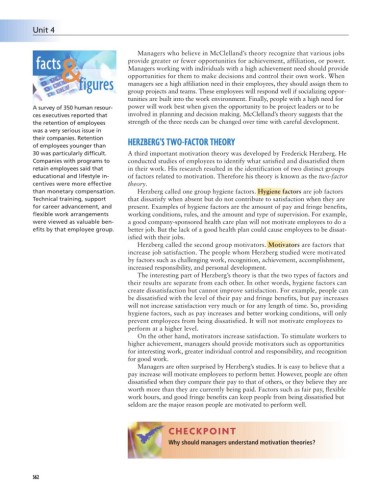Page 375 - Business Principles and Management
P. 375
Unit 4
Managers who believe in McClelland’s theory recognize that various jobs
facts & provide greater or fewer opportunities for achievement, affiliation, or power.
Managers working with individuals with a high achievement need should provide
figures opportunities for them to make decisions and control their own work. When
managers see a high affiliation need in their employees, they should assign them to
group projects and teams. These employees will respond well if socializing oppor-
tunities are built into the work environment. Finally, people with a high need for
A survey of 350 human resour- power will work best when given the opportunity to be project leaders or to be
ces executives reported that involved in planning and decision making. McClelland’s theory suggests that the
the retention of employees strength of the three needs can be changed over time with careful development.
was a very serious issue in
their companies. Retention HERZBERG’S TWO-FACTOR THEORY
of employees younger than
30 was particularly difficult. A third important motivation theory was developed by Frederick Herzberg. He
Companies with programs to conducted studies of employees to identify what satisfied and dissatisfied them
retain employees said that in their work. His research resulted in the identification of two distinct groups
educational and lifestyle in- of factors related to motivation. Therefore his theory is known as the two-factor
centives were more effective theory.
than monetary compensation. Herzberg called one group hygiene factors. Hygiene factors are job factors
Technical training, support that dissatisfy when absent but do not contribute to satisfaction when they are
for career advancement, and present. Examples of hygiene factors are the amount of pay and fringe benefits,
flexible work arrangements working conditions, rules, and the amount and type of supervision. For example,
were viewed as valuable ben- a good company-sponsored health care plan will not motivate employees to do a
efits by that employee group. better job. But the lack of a good health plan could cause employees to be dissat-
isfied with their jobs.
Herzberg called the second group motivators. Motivators are factors that
increase job satisfaction. The people whom Herzberg studied were motivated
by factors such as challenging work, recognition, achievement, accomplishment,
increased responsibility, and personal development.
The interesting part of Herzberg’s theory is that the two types of factors and
their results are separate from each other. In other words, hygiene factors can
create dissatisfaction but cannot improve satisfaction. For example, people can
be dissatisfied with the level of their pay and fringe benefits, but pay increases
will not increase satisfaction very much or for any length of time. So, providing
hygiene factors, such as pay increases and better working conditions, will only
prevent employees from being dissatisfied. It will not motivate employees to
perform at a higher level.
On the other hand, motivators increase satisfaction. To stimulate workers to
higher achievement, managers should provide motivators such as opportunities
for interesting work, greater individual control and responsibility, and recognition
for good work.
Managers are often surprised by Herzberg’s studies. It is easy to believe that a
pay increase will motivate employees to perform better. However, people are often
dissatisfied when they compare their pay to that of others, or they believe they are
worth more than they are currently being paid. Factors such as fair pay, flexible
work hours, and good fringe benefits can keep people from being dissatisfied but
seldom are the major reason people are motivated to perform well.
CHECKPOINT
Why should managers understand motivation theories?
362

